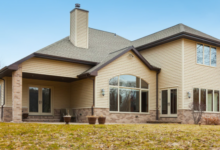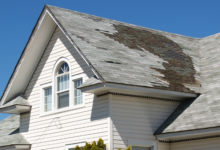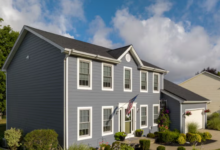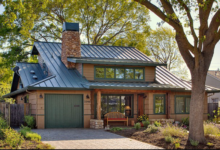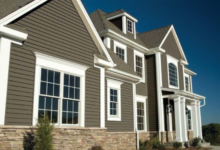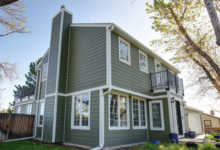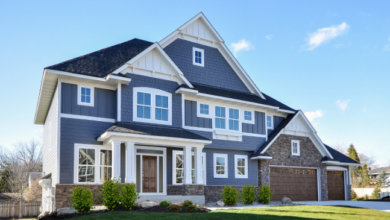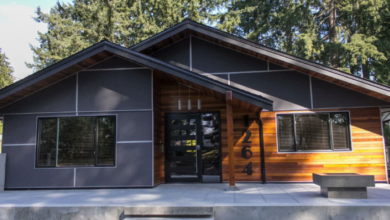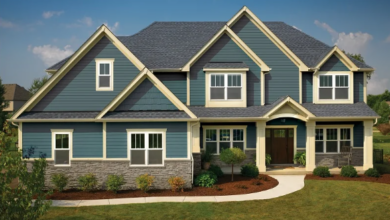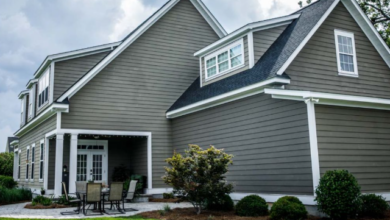Fire-Resistant Siding for Homes: Protect Property with Top Choices
Fire-Resistant Siding for Homes -Discover the best fire-resistant siding for homes. Learn about top-rated materials, benefits, real-world products, and where to buy them to protect your home from fire hazards.
Best Fire-Resistant Siding for Homes: Ultimate Guide to Safety & Protection

Fire-resistant siding is crucial for homeowners living in wildfire-prone areas. Choosing the right siding material can mean the difference between a home surviving a fire or being severely damaged. This guide explores the best fire-resistant siding options, their benefits, real-world product comparisons, and how to purchase them.
What is Fire-Resistant Siding?
Fire-resistant siding is designed to withstand high temperatures and prevent the spread of flames. These materials have a high fire rating, reducing the risk of extensive damage in the event of a wildfire or accidental fire.
Fire-resistant siding is a type of exterior cladding designed to protect buildings from the damaging effects of fire. It’s made from materials that either resist ignition or slow down the spread of flames, providing crucial time for occupants to evacuate and for firefighters to respond. Here’s a more detailed explanation:
Key Characteristics:
- Material Composition:
- Fire-resistant siding is constructed from materials that are less likely to burn or ignite, such as:
- Fiber cement
- Metal (steel or aluminum)
- Brick and stone
- Stucco
- Fire-resistant siding is constructed from materials that are less likely to burn or ignite, such as:
- Fire-Resistance Ratings:
- These materials are often tested and rated based on their ability to withstand fire. Ratings like Class A indicate the highest level of fire resistance.
- Purpose:
- The primary goal of fire-resistant siding is to create a barrier that slows down or prevents the spread of fire to the building’s interior. This is especially important in areas prone to wildfires.
Why It’s Important:
- Enhanced Safety:
- It significantly reduces the risk of fire damage, protecting lives and property.
- Increased Protection:
- It provides an extra layer of defense against embers and flames, which can ignite traditional siding materials.
- Potential Insurance Benefits:
- Installing fire-resistant siding may qualify homeowners for insurance discounts.
In essence:
Fire-resistant siding is a proactive measure to enhance a building’s safety by using materials that resist or slow down the spread of fire.
Fire Ratings Explained
Siding materials are rated based on their resistance to fire:
- Class A: Highest fire resistance (non-combustible materials like fiber cement and brick)
- Class B: Moderate fire resistance
- Class C: Lowest fire resistance (e.g., untreated wood)
Benefits of Fire-Resistant Siding
Fire-resistant siding offers crucial protection for homes, especially in areas prone to wildfires. Here’s a breakdown of the key benefits:
Enhanced Safety:
- Slowed Fire Spread:
- Fire-resistant siding materials are designed to impede the progression of flames. This provides valuable time for occupants to evacuate and for firefighters to respond.
- Protection of Structure:
- It helps safeguard the structural integrity of the home, preventing rapid destruction and minimizing damage.
- Reduced Risk of Ignition:
- Materials like fiber cement and metal siding are non-combustible, significantly reducing the risk of the home catching fire from embers or direct flames.
Financial Advantages:
- Potential Insurance Savings:
- Many insurance companies offer discounts to homeowners who install fire-resistant siding, recognizing the reduced risk of fire damage.
- Increased Property Value:
- Homes with fire-resistant siding are often more attractive to buyers, particularly in wildfire-prone regions, potentially increasing property value.
Additional Benefits:
- Durability:
- Fire-resistant siding materials are often highly durable, withstanding various weather conditions and requiring minimal maintenance.
- Peace of Mind:
- Knowing your home is better protected against fire provides a sense of security and reduces stress.
Key Considerations:
- Material Selection:
- Different materials offer varying levels of fire resistance. It’s essential to choose a material that meets local building codes and addresses specific fire risks.
- Installation:
- Proper installation is crucial to ensure the siding performs as intended.
- Local Regulations:
- It is very important to check local building codes, as in some areas fire resistant siding is required.
In summary, fire-resistant siding is a valuable investment that enhances home safety, potentially reduces insurance costs, and provides peace of mind.
Top Fire-Resistant Siding Materials
1. Fiber Cement Siding
- Fire Rating: Class A
- Pros: Highly durable, resistant to fire, rot, and pests
- Cons: Heavier than other materials, requires professional installation
- Best For: Homes in wildfire-prone areas
2. Brick & Stone Veneer
- Fire Rating: Class A
- Pros: Non-combustible, extremely durable, low maintenance
- Cons: Expensive, requires strong structural support
- Best For: Long-term fire protection
3. Stucco
- Fire Rating: Class A
- Pros: Resistant to fire and extreme weather, energy-efficient
- Cons: Prone to cracking, requires maintenance
- Best For: Mediterranean-style homes
4. Metal Siding (Steel & Aluminum)
- Fire Rating: Class A
- Pros: Non-combustible, lightweight, modern aesthetic
- Cons: Can dent easily, may require additional insulation
- Best For: Contemporary and commercial buildings
5. Treated Wood Siding
- Fire Rating: Class B (can be upgraded to Class A with treatment)
- Pros: Natural look, eco-friendly options available
- Cons: Requires maintenance, can be costly over time
- Best For: Homeowners wanting a wood aesthetic with added fire protection
Real-World Product Examples
1. James Hardie HardiePlank Fiber Cement Siding
- Fire Rating: Class A
- Features: Non-combustible, durable, weather-resistant
- Price: $7 – $12 per square foot
- Where to Buy: James Hardie HardiePlank
2. Eldorado Stone Veneer
- Fire Rating: Class A
- Features: Lightweight, natural stone appearance
- Price: $8 – $15 per square foot
- Where to Buy: Eldorado Stone Veneer
3. Alcoa Aluminum Siding
- Fire Rating: Class A
- Features: Lightweight, low maintenance, corrosion-resistant
- Price: $6 – $10 per square foot
- Where to Buy: Alcoa Aluminum Siding
4. LP SmartSide Fire-Rated Engineered Wood
- Fire Rating: Class B (with fire-resistant treatment)
- Features: Wood aesthetics, termite-resistant
- Price: $5 – $9 per square foot
- Where to Buy: LP SmartSide
5. Quikrete Stucco
- Fire Rating: Class A
- Features: Customizable, energy-efficient
- Price: $4 – $8 per square foot
- Where to Buy: Quikrete Stucco
Comparison Table: Best Fire-Resistant Siding Options

| Product | Fire Rating | Pros | Cons | Price |
|---|---|---|---|---|
| HardiePlank | Class A | Durable, weather-resistant | Heavy, professional installation required | $7 – $12/sq. ft. |
| Eldorado Stone | Class A | Elegant, natural look | Expensive, requires strong support | $8 – $15/sq. ft. |
| Alcoa Aluminum | Class A | Lightweight, corrosion-resistant | Can dent easily | $6 – $10/sq. ft. |
| LP SmartSide | Class B (treated) | Natural wood look, termite-resistant | Requires maintenance | $5 – $9/sq. ft. |
| Quikrete Stucco | Class A | Energy-efficient, customizable | Prone to cracking | $4 – $8/sq. ft. |
How to Buy Fire-Resistant Siding
Buying fire-resistant siding involves careful consideration of materials, ratings, and professional installation. Here’s a step-by-step guide to help you through the process:
1. Research and Material Selection:
- Understand Fire-Resistance Ratings:
- Familiarize yourself with fire-resistance ratings like Class A, B, and C. Class A offers the highest level of protection.
- Look for materials that have been tested and certified by organizations like ASTM (American Society for Testing and Materials) and UL (Underwriters Laboratories).
- Explore Fire-Resistant Materials:
- Fiber Cement:
- A popular choice due to its excellent fire resistance, durability, and versatility.
- Brands like James Hardie are well-regarded.
- Metal Siding (Steel or Aluminum):
- Non-combustible and highly durable.
- Offers a modern aesthetic.
- Brick and Stone:
- Naturally fire-resistant and long-lasting.
- Can be more expensive.
- Stucco:
- A cement based siding that has very good fire resistance.
- Fiber Cement:
- Consider Your Climate and Location:
- If you live in a wildfire-prone area, prioritize materials with the highest fire-resistance ratings.
- Also, consider your local climate’s effects on the siding material.
2. Consult with Professionals:
- Contractors and Siding Specialists:
- Seek advice from experienced contractors who specialize in siding installation.
- They can provide valuable insights into the best materials for your home and location.
- Get multiple quotes.
- Building Inspectors:
- Check local building codes and regulations regarding fire-resistant siding.
- Building inspectors can provide guidance on compliance.
- Insurance Providers:
- Contact your insurance company to inquire about potential discounts for installing fire-resistant siding.
3. Purchasing and Installation:
- Source Materials from Reputable Suppliers:
- Purchase siding materials from trusted suppliers or manufacturers.
- Ensure the materials meet the required fire-resistance standards.
- Hire Qualified Installers:
- Proper installation is crucial for the siding’s performance.
- Choose licensed and experienced installers who are familiar with fire-resistant siding.
- Verify Installation:
- After installation, have the work inspected to ensure it meets building codes and manufacturer specifications.
Key Considerations:
- Budget: Fire-resistant siding can be more expensive than traditional siding. Factor in material and installation costs.
- Aesthetics: Choose a material that complements your home’s style and design.
- Maintenance: Consider the maintenance requirements of the chosen material.
By following these steps, you can make an informed decision and invest in fire-resistant siding that provides optimal protection for your home.
FAQs
1. What is the most fire-resistant siding material?
Fiber cement and brick siding offer the highest fire resistance with a Class A rating.
2. Does fire-resistant siding require special maintenance?
Most require minimal maintenance, but stucco and treated wood may need periodic upkeep.
3. Is fire-resistant siding expensive?
Costs vary, but materials like stucco and fiber cement offer a good balance between affordability and fire protection.
4. Can I install fire-resistant siding myself?
Some materials like aluminum siding are DIY-friendly, but professional installation is recommended for best results.
5. Do insurance companies offer discounts for fire-resistant siding?
Yes, many insurers provide discounts for homes with fire-resistant materials.
Fire-resistant siding is a smart investment that protects your home from fire hazards while enhancing durability and value. Choose the right material today and safeguard your home for years to come!
